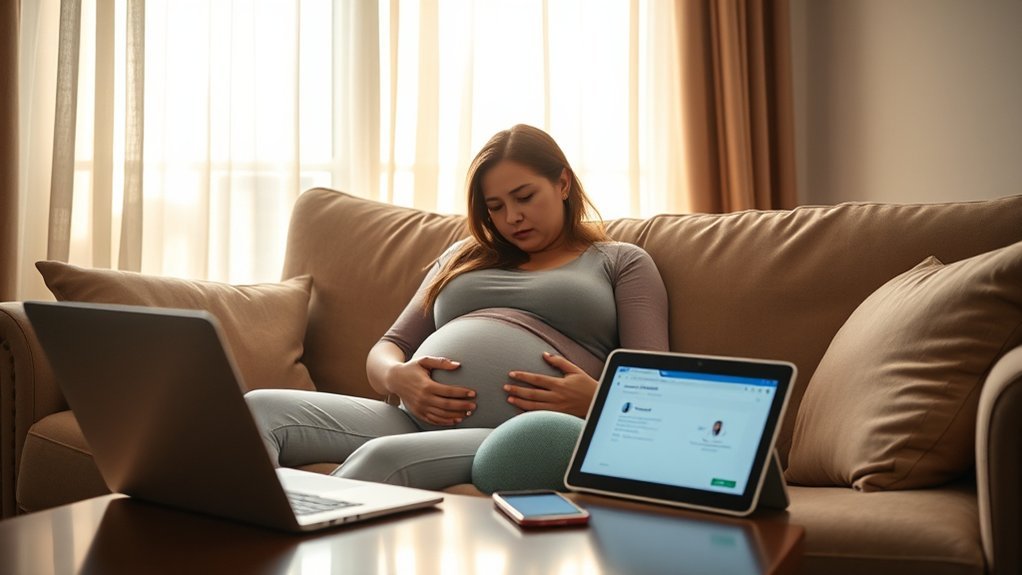Spotting in the first trimester can feel like a sudden rain shower on a clear day, unexpected and often unsettling. Many expectant parents experience light pink or brown discharge, which can stem from benign causes like implantation bleeding or hormonal shifts. While this isn’t always a cause for concern, understanding what it means is essential. So, how do you differentiate between normal spotting and something more serious? Let’s explore this further.
Understanding Spotting: What Is It?

Spotting during the first trimester can be a concerning experience for many expectant mothers. It refers to light bleeding that occurs during early pregnancy, often appearing as pink or brown discharge.
Spotting in the first trimester can be worrying, but it often appears as light pink or brown discharge and may not signal a problem.
Unlike a regular menstrual period, which is typically heavier, spotting is usually much lighter and may not last long. It can happen for various reasons, and understanding this phenomenon is essential for your peace of mind.
While it can be alarming, it’s important to remember that spotting doesn’t always indicate a problem. Many women experience it without complications.
If you notice spotting, it’s important to monitor any accompanying symptoms and consult your healthcare provider for guidance. They can help determine the cause and provide reassurance during this vital time.
Common Causes of Spotting in Early Pregnancy

While experiencing light bleeding can be unsettling, it’s important to know that various factors may contribute to spotting in early pregnancy.
One common cause is implantation bleeding, which occurs when the fertilized egg attaches to the uterine lining. Hormonal changes can also lead to spotting, as your body adjusts to pregnancy.
Additionally, physical activities or sexual intercourse may irritate the cervix, resulting in light bleeding. In some cases, cervical polyps or infections can be responsible for spotting.
While these causes are often benign, understanding them can help ease your concerns. Always remember, your experience is unique, and being informed can empower you during this sensitive time.
When to Seek Medical Attention

Understanding the common causes of spotting can help you feel more at ease, but knowing when to seek medical attention is equally important.
If you experience heavy bleeding, passing clots, or severe cramping, you should contact your healthcare provider immediately. These symptoms may indicate more serious issues, such as a miscarriage or ectopic pregnancy.
Additionally, if the spotting is accompanied by fever, chills, or persistent pain, seek help right away. It’s always better to err on the side of caution; even minor concerns deserve attention.
Open communication with your healthcare provider can provide reassurance and clarity. Remember, your health and peace of mind are paramount during this critical time. Trust your instincts and don’t hesitate to reach out for support.
The Role of Hormones in Early Bleeding
Hormones play an essential role in the early stages of pregnancy, and fluctuations can lead to unexpected bleeding. During the first trimester, levels of progesterone and estrogen rise considerably to support the developing embryo.
However, these hormonal changes can also cause the uterine lining to become unstable, resulting in light spotting. Additionally, the body’s adjustments in response to implantation may trigger similar bleeding events.
Hormonal changes can lead to an unstable uterine lining, causing light spotting during early pregnancy.
While it can be alarming, it’s important to remember that not all bleeding indicates a serious issue. Understanding these hormonal influences can help you navigate this confusing time with greater clarity.
If you experience heavy bleeding or severe pain, reach out to your healthcare provider for guidance and reassurance.
Spotting vs. Miscarriage: Key Differences
Bleeding during the first trimester can be concerning, and it’s important to distinguish between normal spotting and a potential miscarriage. Spotting is typically light bleeding that might appear as brown or pink discharge and can occur after physical activity or sexual intercourse.
It often doesn’t indicate a serious issue, especially if there are no accompanying symptoms.
In contrast, a miscarriage often presents with heavier bleeding, which may include bright red blood and clots, accompanied by cramping or pain.
If you experience significant changes in bleeding patterns or additional symptoms, it’s essential to consult your healthcare provider. Understanding these differences can help you navigate your concerns and seek appropriate care when needed.
How to Manage Anxiety and Stress
While steering through the emotional challenges of early pregnancy, managing anxiety and stress is essential for both your mental well-being and the health of your developing baby.
Here are some effective strategies you can adopt:
- Practice mindfulness or meditation: Taking a few minutes each day to focus on your breath can help reduce anxiety.
- Stay connected: Share your feelings with supportive friends or family members to alleviate worries.
- Limit information overload: While it’s tempting to research every detail, excessive information can heighten anxiety.
Tips for a Healthy First Trimester
To support a healthy first trimester, focus on your nutrition and hydration.
Eating a balanced diet rich in essential nutrients and staying well-hydrated can make a significant difference in your overall well-being.
Additionally, finding a balance between exercise and rest is vital as your body adapts to the changes of pregnancy.
Nutrition and Hydration Tips
As you navigate the early stages of pregnancy, prioritizing nutrition and hydration is vital for both your health and your baby’s development. Proper intake of nutrients can help prevent complications and support fetal growth.
Here are some key tips to guarantee you’re on the right track:
- Focus on Whole Foods: Incorporate fruits, vegetables, whole grains, and lean proteins to provide essential vitamins and minerals.
- Stay Hydrated: Aim for at least 8-10 cups of water daily to support increased blood volume and overall bodily functions.
- Consider Prenatal Vitamins: These can help fill any nutritional gaps, especially folic acid, which is significant during the first trimester.
Exercise and Rest Balance
Maintaining a balance between exercise and rest during the first trimester is key to supporting your body as it undergoes significant changes.
Light to moderate exercise, such as walking or prenatal yoga, can enhance your mood, improve circulation, and alleviate common discomforts. Aim for about 150 minutes of moderate activity each week.
However, it’s essential to listen to your body; fatigue and nausea are common during this stage. Don’t hesitate to prioritize rest when you need it. Incorporating short naps and ensuring adequate sleep can help you cope with fatigue.
Always consult your healthcare provider before starting any new exercise regimen, especially if you’re experiencing complications like spotting.
This balanced approach will help you maintain your health and well-being.
Frequently Asked Questions
Can Spotting Affect the Development of the Fetus?
Spotting itself doesn’t directly affect fetal development, but it can indicate underlying issues. It’s crucial to consult your healthcare provider to understand the cause and verify everything’s progressing as it should for your baby’s health.
Is It Normal to Experience Spotting During Multiple Pregnancies?
Yes, it’s normal to experience spotting during multiple pregnancies. Many women encounter this, often due to hormonal changes or implantation. However, you should always consult your healthcare provider to guarantee everything’s progressing well.
How Does Maternal Age Influence Spotting Frequency?
Like a ticking clock, maternal age can increase the chances of spotting due to hormonal changes and uterine conditions. It is crucial to monitor any symptoms closely and consult your healthcare provider for reassurance.
Can Certain Medications Cause Spotting in Early Pregnancy?
Yes, certain medications can cause spotting in early pregnancy. It’s important to discuss any medications you’re taking with your healthcare provider to guarantee they’re safe and to understand their potential effects on your pregnancy.
Will Spotting Always Lead to Complications Later in Pregnancy?
Spotting doesn’t always lead to complications later in pregnancy. Many women experience spotting without issues. However, it’s essential you monitor any changes and consult your healthcare provider for personalized guidance and reassurance.
Conclusion
In the delicate dance of early pregnancy, spotting can feel like a sudden storm cloud, but remember, it often passes without cause for concern. By understanding the nuances of this experience and staying attuned to your body, you can navigate these weeks with greater ease. Don’t hesitate to reach out for support; your healthcare provider is your compass during this transformative journey. Embrace the beauty of this time, and let knowledge guide you through the uncertainty.
